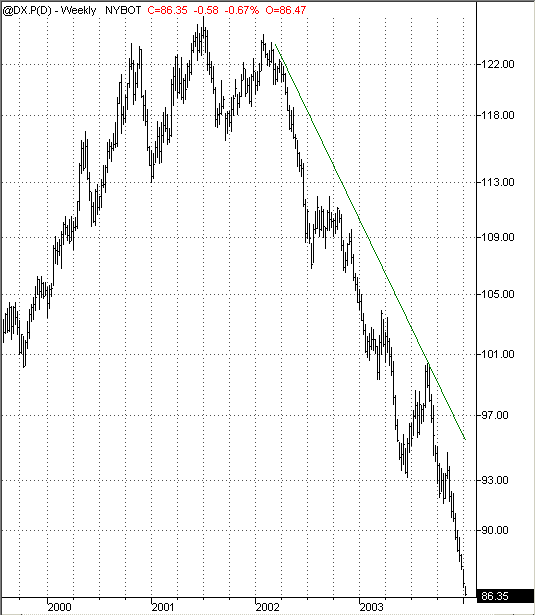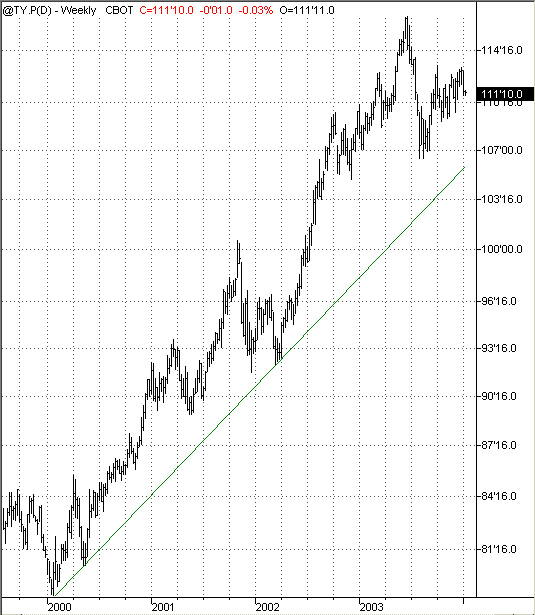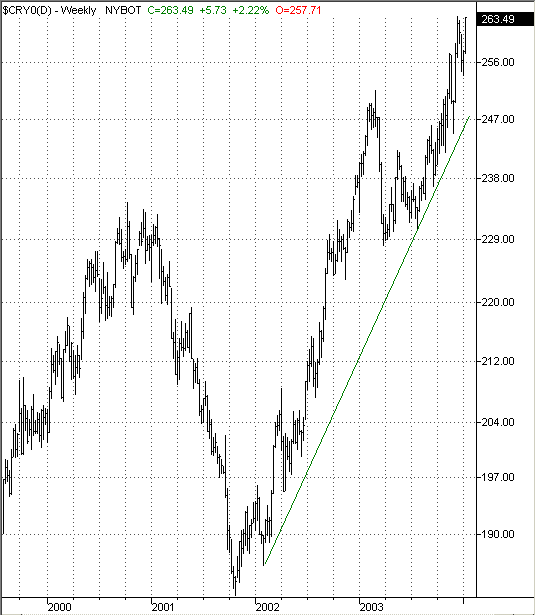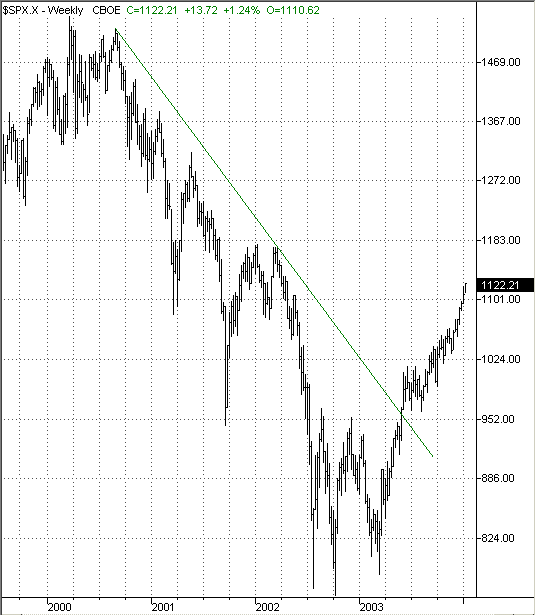
HOT TOPICS LIST
- Strategies
- Stocks
- Buy
- Investing
- Brokers
- Psychology
- Interviews
- Accumulate
- Sell
- Hold
- Spotlight
- Websites
- Candlestick Corner
- Gold & Metals
- Options Trading
LIST OF TOPICS
MARKET UPDATE
Pimping The Dollar
01/07/04 09:44:09 AM PSTby David Penn
Debasing the dollar and other dirty deeds done dirt cheap.
| A little over two months ago, I suggested in Working-Money.com that the US dollar was increasingly oversold and due for a bounce. At the time, the greenback had fallen by some 27% from its summer 2001 peak near 126 (basis US Dollar Index). Greenback bearishness was rampant as famous investor after famous investor proclaimed his disgust at the sorry state of affairs the dollar had become. George Soros, Warren Buffett, Sir John Templeton . . . you couldn't toss a hardback copy of Who's Who In Contemporary Finance across the room without hitting a dollar bear. While all of this was going on, US Treasury Secretary John Snow was wandering about the world making boldly optimistic proclamations about US job growth and swearing that the United States had not abandoned its "strong dollar" policy. The only thing more bizarre than Snow's insistence that a strong-dollar policy was still in effect was his attempt to define exactly what a "strong dollar" was — particularly given the currency's double-digit decline in the two years between the summer of 2001 and the summer of 2003. As The Wall Street Journal reported back in May 2003:
[Snow] said the US government no longer measures the dollar's strength by its market value against the other major currencies — the long-accepted premise of that policy. Instead, Mr. Snow said "strong" refers to such aspects of the dollar as the confidence it inspires in the public and its resistance to counterfeiting. To his credit, reporter Michael Phillips did add immediately that this new strategy carried more than enough risk. "Currency traders carefully parse Mr. Snow's words," Phillips wrote, "and his comments could trigger another selloff in the already-weakened dollar." For the record, the US dollar index was trading near 95-94 at the time of Snow's comments. The dollar bounced to as high as 100 by summer's end before resuming its descent (see Figure 1). As of this writing, the US Dollar Index was trading at approximately 88.
Figure 1: After a brief bounce to 100 in the third quarter of 2003, the dollar's apparently endless slide resumed.
THE CONFIDENCE GAMEAm I the only one who reads in Secretary Snow's comments the same sort of "damn the fundamentals, full speed ahead!" logic that thrived during the stock market bubble of the late 1990s? In both cases, long-established methods for valuation have been abandoned. And not because these methods of valuation — say, book value in stocks and market value in currencies — have been proved wanting, but because what these valuation methods reveal is something that nobody wants to hear. Setting aside the absurdity of suggesting that anyone outside of the US Treasury Department considers dollar strength in the context of its susceptibility to counterfeiting, the notion that "confidence" in a currency can exist apart from the market value of that currency is an interesting excursion from logic. When Snow says "you want the currency to be a good store of value" or that "you want it to be something people are willing to hold" — apparently oblivious to the reality that the US dollar has not been a good store of value in the past two years and, given the strength of the gold market, is less a currency that investors choose to overweight — it is of little surprise that the dollar has plunged through technical support levels that, had Snow perhaps been silent, might have actually stemmed the decline. The only thing scarier than silence, or even soberly observed bad news, is bad spin. And when it comes to the dollar, Snow has been a regular dervish of nonsense. What is the positive take on the dollar's decline? Cobbling together a consensus view is difficult, insofar as those who are bullish as well as bearish have agreed that a retreat from the "King Dollar" policies of the late 1990s (and from former US Treasury Secretary Robert Rubin) paves the way for either (a) increased US exports from a beleagured manufacturing sector and/or (b) a global economic shift away from dependence on the United States as the sole engine of economic growth. The notion being advanced by the "dollar's orderly decline" crowd is that a weaker dollar will make it easier for the US to sell its goods abroad. As the currencies of other nations rise in value, their holders will be able to consume more American goods than they did previously. This, in the minds of people like Morgan Stanley's chief economist Stephen Roach, will help the world shift from a paradigm that demands strong (if not single-handed) consumption from the United States to one of global economic "balance."
THE DOLLAR PIMPEDUnfortunately, rather than contribute to global rebalancing through stimulating domestic demand in countries like Japan and China as well as regions like Europe, the falling dollar appears only to have stimulated a dramatic shift toward commodity investment — chiefly gold and crude oil — as well as a sideshow of asset inflation in real estate and equities. The falling dollar has also failed to spur the sort of debt-retiring retrenchment that was common during difficult economic times in the past. As Roach observed recently:
What the markets are missing, in my view, is the price the world has paid to climb out of the near-deflationary abyss of the last recession. Central banks have made the riskiest bets in modern history — policy rates of "zero" in Japan, 1% in America, and 2% in Europe. At the same time, fiscal authorities have upped the ante as never before, with government budget deficits of 7% in Japan, 4% in America, and 3% in Europe. Balance sheets across the spectrum — governments, corporations, and households — operate under this new paradigm of easy credit and increasing debt. Part of the bitter irony about a reflationary recovery is that while reflation does make it easier to retire debt, it also makes it less painful to both carry debt and to, in fact, add to those debt levels. Dollar-denominated debt that crushed telecommunications companies in 2000, for example, when the dollar was above 125, are a completely different matter when those same liabilities can be repaid with a dollar that is at 105, or 95, or 85. But the capacity for shouldering greater debt also increases, giving a new lease on life for corporations (as well as governments and individuals), empowering them to perform feats of expansion, growth, and spending that would have been impossible without additional (albeit cheaper in value) money. It is this "seemingly open-ended appetite for leverage" in Roach's colorful phrase that looms like a dark cloud over any sense of sustainable global economic recovery capable of producing both profits for corporations and jobs for the rest of us (Figure 2).
Figure 2: Although overextended for most of 2003, the government long bond market will require an especially sharp correction before any change in trend can be considered. But if the dollar's decline is so terrible and so destructive, then where, as Bugs Bunny's Martian antagonist used to proclaim, is the "earth-shattering kaboom"? Where is the debt crisis? Where is the revulsion from the foreign lenders from whom the US economy requires billions of dollars in new investments daily just to pay its bills? One place many commentators expected to see the "kaboom" but didn't was the government bond market. Indeed, it is quite a spectacle — in a world of $400-per-ounce gold and $30 barrels of crude oil — to see bond prices of 10-year Treasuries remain as relatively stable as they have been. In fact, the long-term trend for government long bonds (the 10-year and the 30-year notes and bonds, respectively) is still quite intact and would have to be considered so even if prices for the 10-year Treasury, for example, fell as low as 105. Except for a brief panic over the summer of 2003 when bond investors became concerned that a rising stock market would lead to the kind of surging economic growth that would almost inevitably lead to higher interest rates, long government rates have remained tame, content with the Federal Reserve Board's assurances that its interest rate policy would remain "accommodative" (that is, maintain low rates) for a "considerable period of time" (as long as humanly possible). How is it possible that a massive reflation campaign in the US economy hasn't significantly damaged the government bond market? There are a variety of answers to this question, chief among which is the willingness (or desperate need) of foreign investors to recycle the proceeds of their sales of goods and services to the United States into investments into US government and agency (for example, Fannie Mae and Freddie Mac) debt. As Roach — among many other critics of the US economy — has noted, "America is more dependent than ever on the 'kindness of strangers' to fund the excesses of a savings-short US economy." This is no one-way street, however. As long as US consumption drives the global economic engine, its trading partners need to make sure that the US continues to spend — even if this means, by way of metaphor, lending a high-risk borrower the only money that allows him to shop in your store.
WHERE THE BOOMS AREIf there has yet to be a "kaboom," there at least has been a "boom" as the US Treasury puts the dollar out in the street, trading the easy virtue of a fiat currency for the quick thrills of deficit spending and asset inflation. And that boom has been most evident in the commodities markets, a chart of which looks like a chart of the dollar turned upside down. Commodities, as measured by the CRB index, set a multiyear high in the first quarter of 2003 and then went on to best that high in the fourth quarter. Which commodities have benefited? To steal a line from the young Marlon Brando in The Wild One, "Whaddaya got?" Crude oil has remained above $30 a barrel for months now, gold has climbed above $400 an ounce, and international currencies from the finance-based (euro and pound) to the commodity-based (Australian and Canadian dollars) have soared to historic highs in many instances. In addition to the dramatic levels mentioned, consider the performance of a variety of commodities since the dollar's decline began in earnest in mid- to late 2001:
Figure 3: This chart of the CRB index shows commodities prices bouncing off trendline support in late 2003 and headed higher.
But the flood of cheap dollars has not only lifted the commodities markets; the financial asset markets of the world have enjoyed the surge of liquidity as well. While the first leg of the US dollar's decline, a move that ended at the beginning of the third quarter of 2002, accompanied a falling market in stocks, the resumption of the dollar's bear market in the fourth quarter of 2002 saw the opposite. The Standard & Poor's 500 bottomed early in third-quarter 2002, tested that bottom in first-quarter 2003, and the rest has been bull market history as the S&P 500 advanced from just over 800 to just over 1085 by late fourth-quarter 2003. Over the same time period, the dollar fell from 102 in first-quarter 2003 to about 88 by the end of the fourth quarter. The intermarket relationships between stocks, commodities, bonds, and the dollar remains as fascinating and complex as it always has. The excursion into a near-deflationary environment in the US saw a brief period during which the traditional stock-prices-follow-bond-prices relationship became frayed, as the stock market melted down in the second half of 2002. Yet it is clear that this typical mild-inflation-to-disinflation paradigm remains the dominant one for today's markets. The stock market rally in 2003 notoriously stalled during the summer months, just as interest rates spiked upward and the dollar bounced. As soon as interest rates eased and the dollar resumed its slide, the stock market picked up again. This is exactly what should be expected in a relatively benign inflationary environment in which the sense of rising wealth by way of higher asset values in stocks and real estate trumps the feeling of impoverishment that anyone who tried to exchange a dollar for goods or services outside the United States would notice instantly.
Figure 4: The only market in our intermarket four to have broken out of its long-term trend, the S&P 500 has advanced consistently and powerfully throughout 2003. There has even been talk of the United States moving toward a two-tiered currency system, with a dollar for domestic consumption and a separate dollar for international trade. Regardless of the feasibility (or lack thereof) of such a plan, the fact that such a notion has even been bandied about underscores a certain "ignorance is bliss" ethos with regard to most American investors. For better or worse, a run in the S&P 500 from 800 to 1080 in US dollars means something far different from a similar advance in euros, or British pounds, or Australian dollars. But for investors who rarely set foot outside the US, exchange rates are just another distinction without a difference — at least, for now.
David Penn may be reached at DPenn@Traders.com.
SUGGESTED READINGPhillips, Michael M. [2003]. "Newly defined 'strong dollar' signals change in US policy," The Wall Street Journal: May 19.Roach, Stephen [2003]. "Growth at what cost?" Morgan Stanley Global Economic Forum: December 1. Wolf, Martin [2003]. "The underrated dangers of the dollar's orderly decline," Financial Times: December 17.
Charts courtesy of TradeStation
Current and past articles from Working Money, The Investors' Magazine, can be found at Working-Money.com.
|
Technical Writer for Technical Analysis of STOCKS & COMMODITIES magazine, Working-Money.com, and Traders.com Advantage.
| Title: | Traders.com Technical Writer |
| Company: | Technical Analysis, Inc. |
| Address: | 4757 California Avenue SW |
| Seattle, WA 98116 | |
| Phone # for sales: | 206 938 0570 |
| Fax: | 206 938 1307 |
| Website: | www.traders.com |
| E-mail address: | DPenn@traders.com |
Traders' Resource Links | |
| Charting the Stock Market: The Wyckoff Method -- Books | |
| Working-Money.com -- Online Trading Services | |
| Traders.com Advantage -- Online Trading Services | |
| Technical Analysis of Stocks & Commodities -- Publications and Newsletters | |
| Working Money, at Working-Money.com -- Publications and Newsletters | |
| Traders.com Advantage -- Publications and Newsletters | |
| Professional Traders Starter Kit -- Software | |
PRINT THIS ARTICLE

|

Request Information From Our Sponsors
- StockCharts.com, Inc.
- Candle Patterns
- Candlestick Charting Explained
- Intermarket Technical Analysis
- John Murphy on Chart Analysis
- John Murphy's Chart Pattern Recognition
- John Murphy's Market Message
- MurphyExplainsMarketAnalysis-Intermarket Analysis
- MurphyExplainsMarketAnalysis-Visual Analysis
- StockCharts.com
- Technical Analysis of the Financial Markets
- The Visual Investor
- VectorVest, Inc.
- Executive Premier Workshop
- One-Day Options Course
- OptionsPro
- Retirement Income Workshop
- Sure-Fire Trading Systems (VectorVest, Inc.)
- Trading as a Business Workshop
- VectorVest 7 EOD
- VectorVest 7 RealTime/IntraDay
- VectorVest AutoTester
- VectorVest Educational Services
- VectorVest OnLine
- VectorVest Options Analyzer
- VectorVest ProGraphics v6.0
- VectorVest ProTrader 7
- VectorVest RealTime Derby Tool
- VectorVest Simulator
- VectorVest Variator
- VectorVest Watchdog




